Satas D., Tracton A.A. (ed.). Coatings Technology Handbook
Подождите немного. Документ загружается.

This Page Intentionally Left Blank
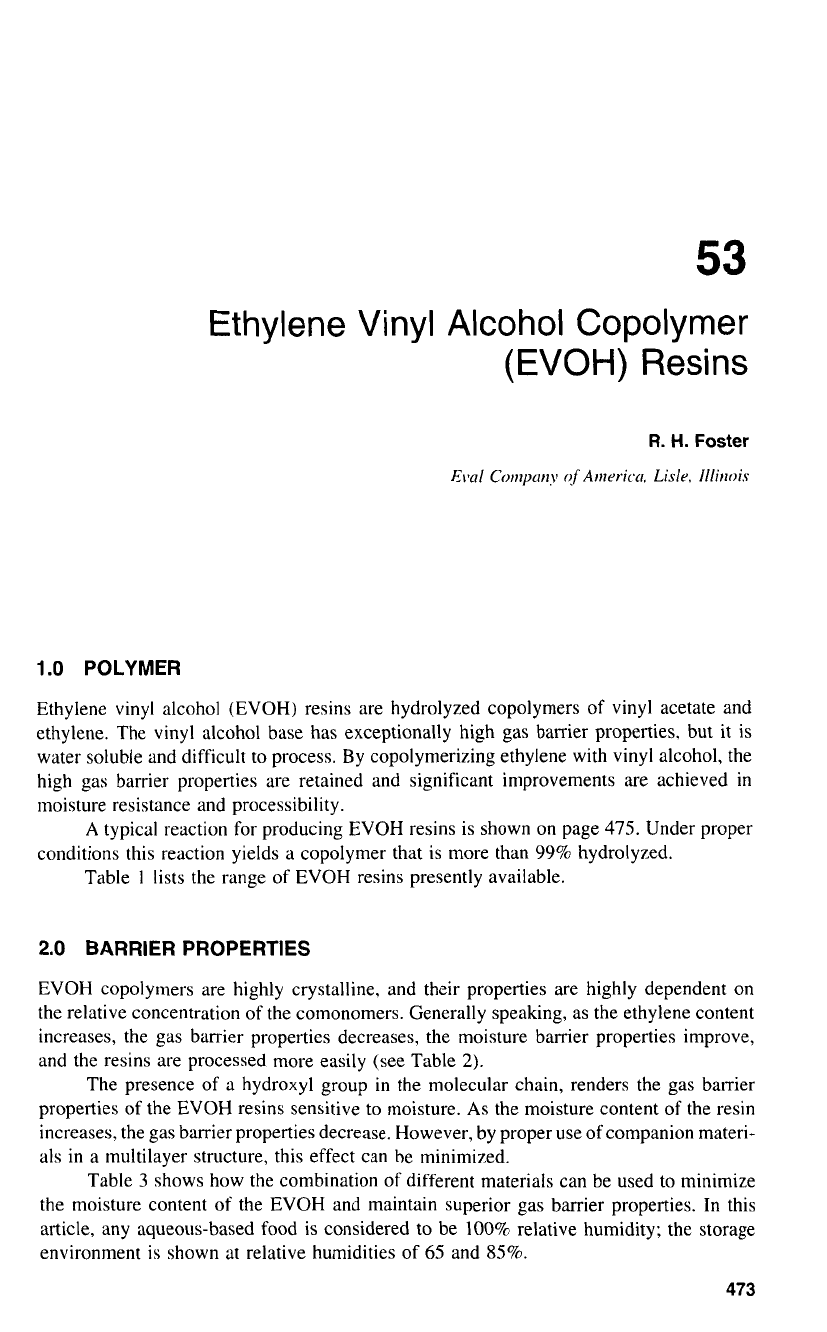
53
Ethylene Vinyl Alcohol
Copolymer
(EVOH)
Resins
1
.O
POLYMER
Ethylene vinyl alcohol (EVOH) resins are hydrolyzed copolymers
of
vinyl acetate and
ethylene. The vinyl alcohol base has exceptionally high gas barrier properties. but it is
water soluble and difficult
to
process. By copolymerizing ethylene with vinyl alcohol, the
high
gas
barrier properties are retained and significant improvements
are
achieved
in
moisture resistance and processibility.
A
typical reaction for producing EVOH resins is shown on page
475.
Under proper
conditions this reaction yields
a
copolymer that is more than
99%
hydrolyzed.
Table
1
lists the range of EVOH resins presently available.
2.0
BARRIER PROPERTIES
EVOH copolymers are highly crystalline, and their properties are highly dependent on
the relative concentration of the comonomers. Generally speaking, as the ethylene content
increases, the gas barrier properties decreases, the moisture barrier properties improve,
and the resins are processed more easily (see Table
2).
The presence
of
a hydroxyl group
in
the molecular chain, renders the gas barrier
properties of the EVOH resins sensitive
to
moisture.
As
the moisture content
of
the resin
increases, the gas barrier properties decrease. However, by proper use of companion materi-
als
in a multilayer structure, this effect can be minimized.
Table
3
shows how the combination of different materials can be used to minimize
the moisture content of the EVOH and maintain superior gas barrier properties. In this
article, any aqueous-based food is considered
to
be
100%
relative humidity; the storage
environment is shown at relative humidities of
65
and
85%.
473
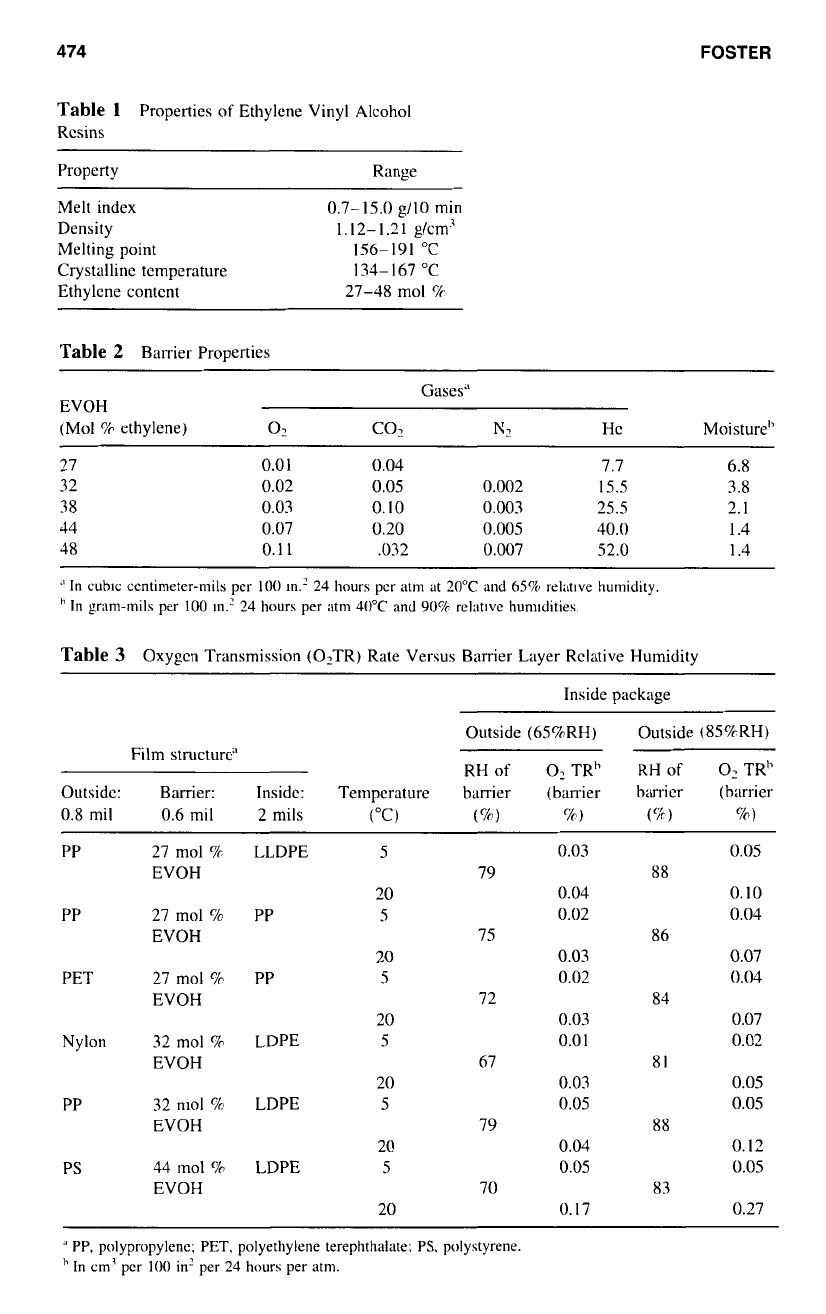
474
FOSTER
Table
l
Properties
of
Ethylene Vinyl Alcohol
Rcsins
Property Range
Melt index
0.7-15.0 g/10
min
Density
1.12-1.21
g/cm3
Melting point
156-191
"C
Crystalline temperature
134-167
"C
Ethylene content
27-48
mol
%
Table
2
Barrier Properties
EVOH
(Mol
p/c
ethylene)
02
COz
N2 He Moisture"
27 0.0
1
0.04 7.7
6.8
32 0.02 0.05 0.002 15.5 3.8
38 0.03
0.
10 0.003 25.5 2.1
44 0.07 0.20 0.005 40.0 1.4
48
0.1
1
,032 0.007 52.0 1.4
Gases"
In
cublc
ccntimeter-mils per
100
In.' 24 hours per atnl at
20°C
and
65%
relmvc humidity.
'l
In gram-mils per
100
In.'
24 hours per atm 40°C
and
909
rclatlve hunudities.
Table
3
Oxygcn Transmission (O?TR) Rate Versus Barrier Layer Rclative Humidity
Inside package
Outside (65%RH) Outside (85%RH)
RH
of
O2
TR" RH
of
0:
TR"
Outside: Barrier: Inside: Temperature barrier (barrier barrier (barrier
0.8
mil
0.6
mil
2
mils
("C)
(%)
76)
(%)
%)
Film structurf'
PP
27
mol
%
LLDPE
EVOH
PP
27
mol
c/o
PP
EVOH
PET
27
mol
p/c
PP
EVOH
Nylon
32
mol
%
LDPE
EVOH
PP
32
mol
%
LDPE
EVOH
PS
44
mol
70
LDPE
EVOH
5
20
5
20
5
20
5
20
5
20
5
20
0.03
79
0.04
0.02
0.03
0.02
0.03
0.0
1
0.03
0.05
0.04
0.05
0.17
15
72
67
79
70
0.05
0.10
0.04
88
86
0.07
0.04
0.07
0.02
0.05
0.05
0.12
0.05
84
81
88
83
0.27
"
PP,
polypropylene;
PET,
polyethylene terephthalate;
PS.
polystyrene
"
In
cm' pcr
100
in' per 24 hours per atm.
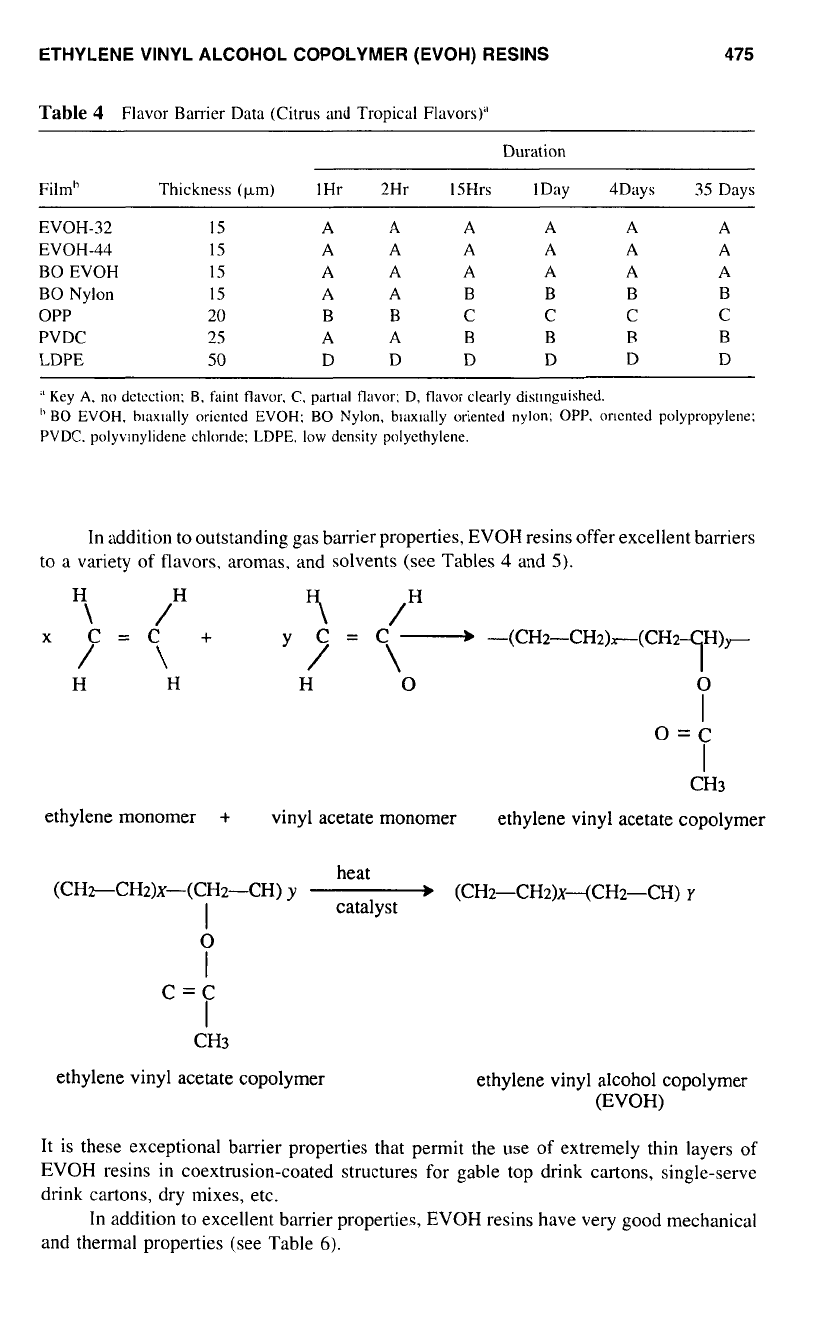
ETHYLENE VINYL ALCOHOL COPOLYMER (EVOH) RESINS
475
Table
4
Flavor Barrier Data (Citrus
and
Tropical Flavors)''
Duration
Filmh Thickness (pm) 1Hr 2Hr ISHrs IDay 4Doys
3.5
Days
EVOH-32
IS
A A
A
A
A
A
EVOH-44
IS
A
A
A
A
A
A
BO EVOH
1s
A
A A A A
A
BO Nylon
IS
A
A
B B B
B
OPP
20
B B C C C C
PVDC
25
A
A
B
B B B
LDPE
50
D
D D D D D
.'
Key
A,
no detection:
B.
faint
flavor.
C.
part~el
flavor:
D, flavor clearly distlnguished.
"
BO
EVOH, blaxlally oricntcd EVOH:
BO
Nylon, blaxlally oriented nylon; OPP. orlcnted polypropylene:
PVDC. polyvlnylidene chlorde; LDPE.
low
density polyethylene.
In addition
to
outstanding gas barrier properties, EVOH resins offer excellent barriers
to
a
variety of flavors, aromas. and solvents (see Tables
4
and
5).
H
\
+
y
C
=
C
\
/\
H
H
H
0 0
I
o=c
I
CH3
ethylene monomer
+
vinyl acetate monomer ethylene vinyl acetate copolymer
0
I
c=c
I
CH3
ethylene vinyl acetate copolymer
ethylene vinyl alcohol copolymer
(EVOH)
It is these exceptional barrier properties that permit the use of extremely thin layers
of
EVOH resins
in
coextrusion-coated structures for gable top drink cartons, single-serve
drink cartons, dry mixes, etc.
In
addition to excellent barrier properties, EVOH resins have very good mechanical
and thermal properties (see Table
6).
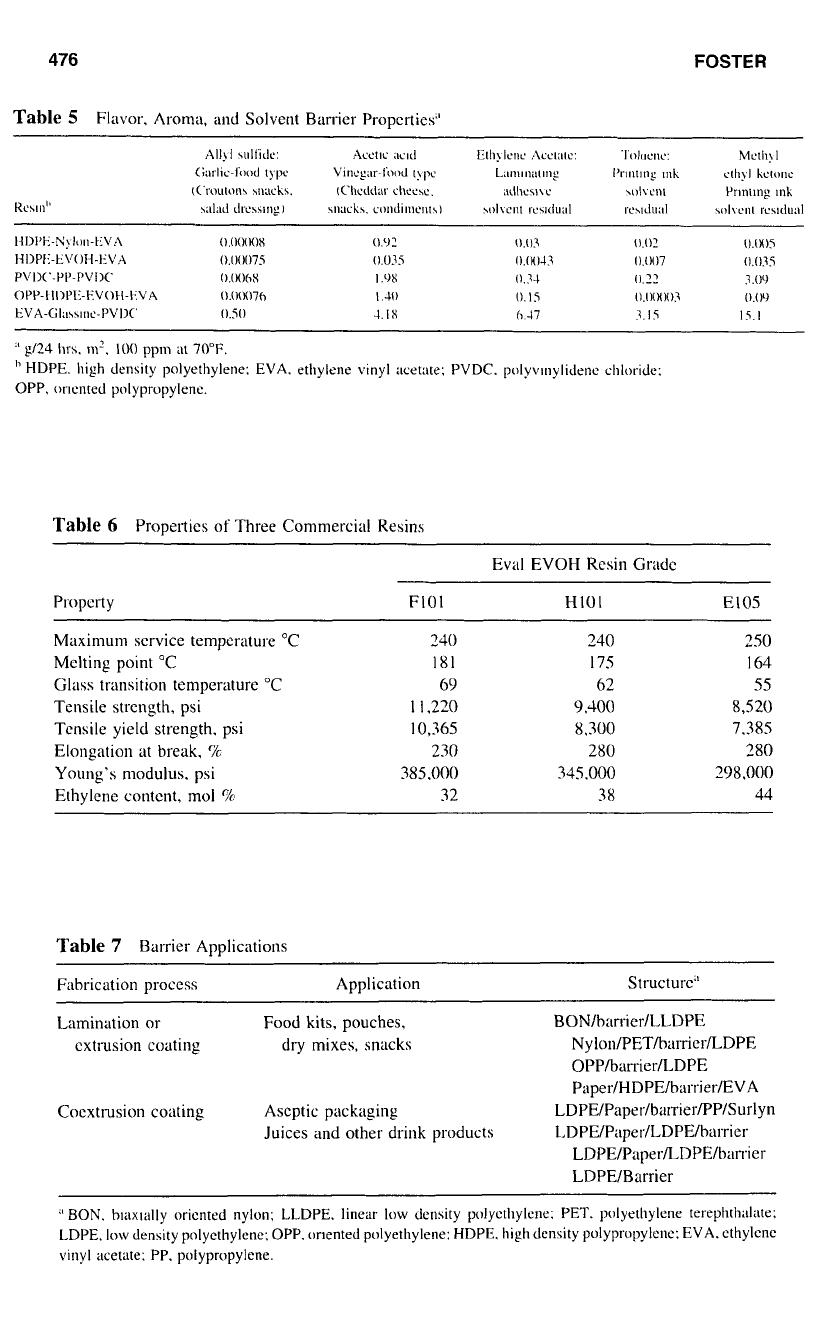
476
FOSTER
Table
5
Flavor.
Aroma,
and
Solvent Barrier Propcrties"
l<cs111''
l~l~l'~-~~l,lll-t~v~~ O.O(KK)X
O.[J2
0.03
0.07
0.W5
l~l~Pf-~\'o~~l-l~~~,~
0.00075
Il.U35
O.lMl47
Il.lM)7
0.035
Pvlx-Pl'-Pv~~c
OSMK~X
I
.Y8
0.74
11.72
3.09
OPP-I
ll~l'l-EVOWl~VA
0.0(K)7h
I
.40
0.15
o.iun)o3
Il.O'>
EVA-Cilil\Slllc-PVI)('
0.50
4.IX
(1.47
3.15 15.1
''
g124
lirs.
in2,
100
ppiii
at
70°F.
OPP. oriented polypropylene.
HDPE. high density polyethylene: EVA. ethylene vinyl ;wetate: PVDC. pdyviiiylideiic cliloride:
Table
6
Propertics
of
Three Commercial Resins
Propcrt y
Eva1 EVOH Resin Gradc
FlOl
HI01 El05
~ ~~ ~~ ~ ~~ ~~~ ~~~~
Maximum scrvice tempcrature
"C
240 240 250
Glass
transition temperature
"C
69
62
55
Tensile yield strength. psi
10,365 8.300 7.385
Elongation at break,
Q
230 280 280
Young's
modulus. psi
385.000 34s.000 298.000
Ethylcnc contcnt,
mol
c/r
32 38
44
Melting point
"C
181 I75 164
Tensile strength, psi
1
1.220
9.400 8,520
Table
7
Barrier
Applications
Fabrication process Application
s
t
rUctUrC:l
~~ ~~
Lamination
or
Food
kits, pouches. BONlbnrrierlLLDPE
cxtrusion coating
dry
mixes, snacks Nylon/PET/b~u-ricrnDPE
OPPharrierlLDPE
PaperlHDPE/barrier/EV A
Cocxtt-usioii coating Aseptic packaging
LDPE/Paper/batrierlPPISurlyn
Juices and other drink products
L,DPE/P~iper/LDPE/bairier
LDPE/PapernDPE/li~iirier
LDPElBarrier
"
EON.
hiaxially oriented nylon; LLDPE. linear
low
density polyethylene: PET. pc~lyethylene terephth:thte:
LDPE. low density polyethylene: OPP. oriented polyethylene: HDPE.
high
density polyprc>pylciic: EVA. ethylene
vinyl
acetate:
PP. polypropylene.
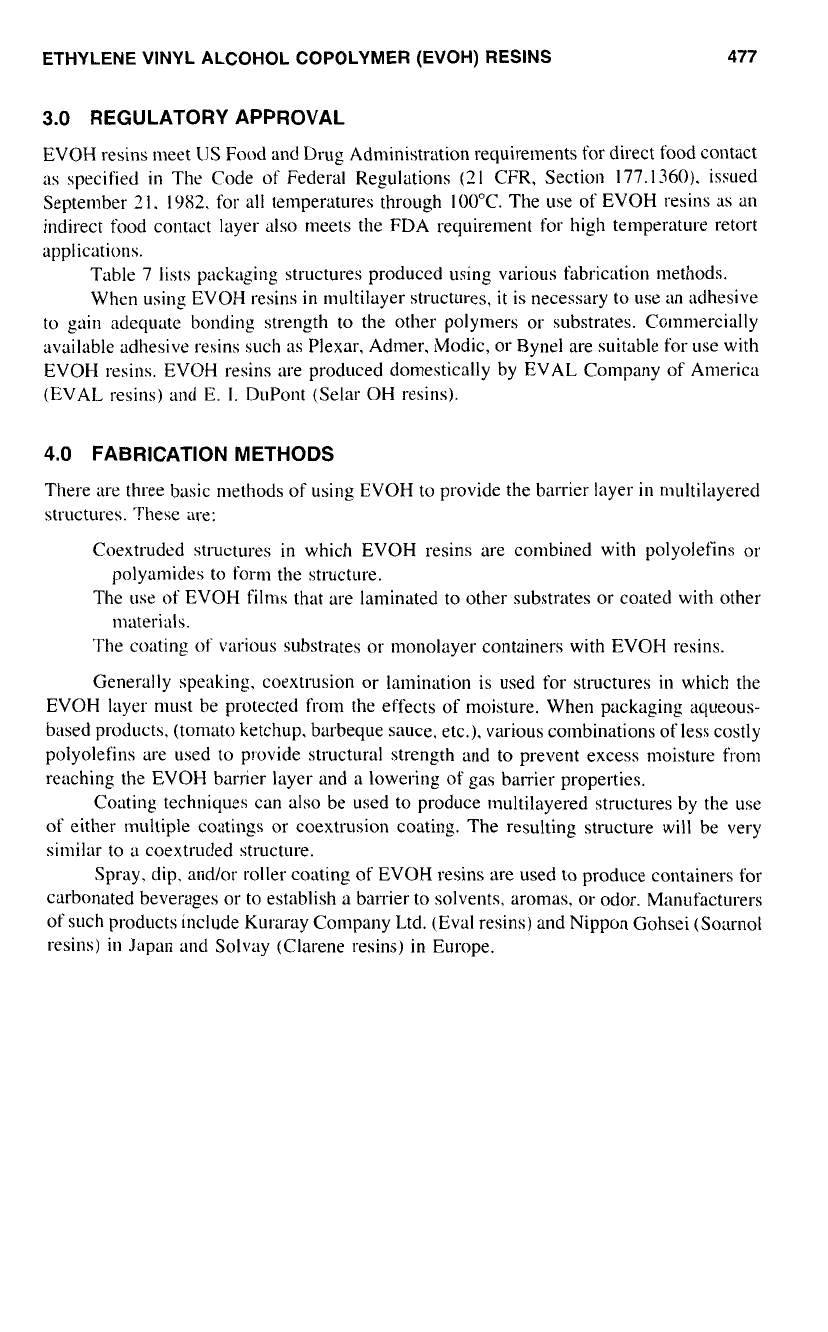
ETHYLENE VINYL ALCOHOL COPOLYMER (EVOH) RESINS
477
3.0
REGULATORY APPROVAL
EVOH resins meet
IJS
Food and Drug Administration requirements for direct food contact
as
specified
in
The Code of Federal Regulations
(3-
I
CFR, Section
177.1360).
issued
September
31.
1982,
for all temperatures through I00"C. The use of EVOH resins as an
indirect food contact layer also nleets the FDA requirement for high temperature retort
applications.
Table
7
lists packaging structures produced using various fabrication methods.
When using EVOH resins
in
multilayer structures,
it
is necessary to use an adhesive
to gain adequate bonding strength
to
the other polymers or substrates. Cotnmercially
available adhesive resins such as Plexar. Admer, Modic, or Bynel are suitable for use with
EVOH resins. EVOH resins are produced domestically by EVAL Company of America
(EVAL resins) and E.
I.
DuPont (Selar OH resins).
4.0
FABRICATION METHODS
There are three basic methods
of
using EVOH to provide the barrier layer
in
multilayered
structures. These are:
Coextruded structures
in
which EVOH resins are combined with polyolefins or
The
use
of EVOH films that are lanlinated
to
other substrates or coated with other
polyamides to form the structure.
materials.
The coating of various substrates or monolayer containers with EVOH resins.
Generally speaking, coextrusion or lamination is used for structures
in
which the
EVOH layer must be protected from the effects
of
moisture. When packaging aqueous-
based products. (tomato ketchup, barbeque sauce. etc.). various combinations of less costly
polyolefins are used to provide structural strength and
to
prevent excess nloisture from
reaching the EVOH barrier layer and a lowering
of
gas barrier properties.
Coating techniques can also be used
to
produce multilayered structures by the use
of
either multiple coatings or coextrusion coating. The resulting structure will be very
similar to
a
coextruded structure.
Spray. dip, and/or roller coating of EVOH resins are used to produce containers for
carbonated beverages or to establish a barrier
to
solvents, aromas, or odor. Manufacturers
of such products include Kuraray Company Ltd. (Eva1 resins) and Nippon Gohsei (Soarnol
resins)
in
Japan and Solvay (Clarene resins)
in
Europe.
This Page Intentionally Left Blank

54
Elastomeric
Alloy
Thermoplastic
Elastomers
Charles
P.
Rader
Adlmc~erl
Eltrstorrrer
Systerrls.
L.
P,.
Akrorl.
Ohio
A thermoplastic elastomer (TPE) is
a
material with the functional performance ofa thermo-
set rubber. but the processibility of a conventional thermoplastic. Elastomeric alloys (EAs)
are a generic class
of
TPEs composed of two or more polymer systems between which
a
synergistic interaction has arisen, giving rise to properties significantly better than those
expected from a single blend of these polymer systems. EAs are medium performance,
moderate cost TPEs.
Figure
1
compares the generic classes
of
TPEs
by performance and by cost. Thus,
EAs have higher performance and cost more than either the styrenic or olefinic blend
TPEs whereas thermoplastic polyurethanes. copolyesters, and polyamides cost more and
give higher performance than EAs.
1
.O
PROPERTIES
Elastomeric alloys may have either two phases or a single phase. A two-phase EA is an
alloy
of
vulcanized rubber with a thermoplastic polyolefin. The alloying
of
these two
polymeric phases gives rise
to
higher ultimate tensile strength, improved retention of
physical properties at elevated temperature, improved resistance
to
hydrocarbon fluids,
lower compression set. and lower tension set. These properties thus qualify EAs for applica-
tions for which a simple rubber-polyolefin blend would be inadequate.
The need for a compatibilizer
to
stabilize intermingling of the rubber and polyolefin
phases of a two-phase EA will be determined by their relative solubility parameters.
Having essentially equal solubility parameters for the two phases eliminates the need for
a
compatibilizer whereas
a
significant difference between the solubility parameters requires
;I
compatibilizer.
479

480
High
Cost
Low
cost
RADER
Polyamides
Copolyesters
Urethanes
Elastomeric Alloys
Olefinic Blends
Styrenics
Low
Performance General Purpose High Performance
Commodity Specialties
Single-phase EAs are said
to
consist
01
an ethylene
vinyl
acetate-acrylate ester-
polyolefin blend with significant plasticizer content. They may or may not contain carbon
black.
Two-phase EAs range
in
hardness from
55
Shore A to
SO
Shore
D.
EAs derived
from ethylene propylene diene monomer (EPDM) rubber and polypropylene have
;I
service
temperature range from
-60°C to
135°C
in
air. Two-phase EAs from nitrile rubber and
polypropylene have a service temperature ranging from
40°C
to
125°C
in
air. The specific
gravity of single-phase EAs ranges from
1.2
to
l.?.
and that of two-phase EAs from
0.9
to
l
.O.
Although the properties of
an
EA are quite competitive with those
of
a
thermoset
rubber. the ultimate tensile strength is generally significantly lower relative
to
a thermoset
rubber
of
the same hardness. This difference is generally of little consequence
in
actual
service, since very few rubber articles are used at an elongation anywhere close to the
ultimate limit.
The fatigue resistance of two-phase EAs is truly outstanding. and the compression
and tension set are competitive with those of thermoset rubber stocks specially
COIW
pounded for these properties. This is an unusual combination
of
properties
for
;L
specific
rubber composition.
Fluid resistance of EPDM rubber based two-phase
EAs
is quite broad. These materi-
als are extremely resistant to water, aqueous solutions (including acids
and
bases).
and
a
variety of polar organic fluids. In nonpolar. hydrocarbon fluids, these materials retain their
physical properties quite well: however. they do experience significant swell. If low swell
is
a criterion for adequate service with
an
EA. the use of one based
on
nitrile rubber and
polyolefin is recommended. These alloys give much lower swell
in
hydrocarbon fluids
than those based on EPDM rubber.
2.0
PROCESSING
EAs capitalize on the numerous processing advantages of
a
TPE. For example.
in
addition
to
being fully cotnpounded. EAs are simpler to process. have shorter processing times,
permit recycling
of
scrap. have lower energy consumption. allow tighter. more economical
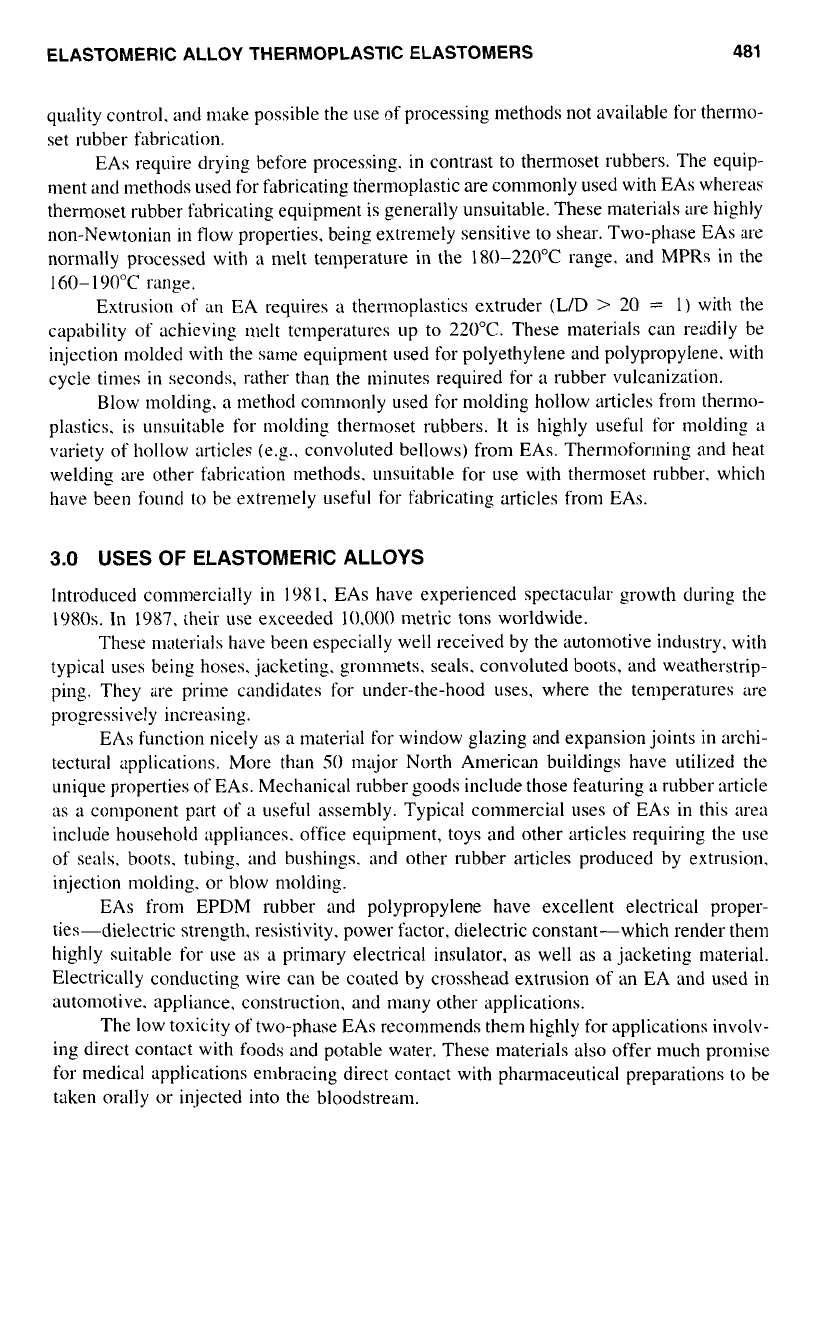
ELASTOMERIC ALLOY THERMOPLASTIC ELASTOMERS
481
quality control. and make possible the use of processing methods
not
available for thermo-
set rubber fabrication.
EAs require drying before processing.
in
contrast to thermoset rubbers. The equip-
ment and methods used for fabricating thermoplastic are commonly used with EAs whereas
thermoset rubber fabricating equipment is generally unsuitable. These materials are highly
non-Newtonian
in
tlow properties. being extremely sensitive to shear. Two-phase EAs are
normally processed with
a
melt temperature in the
180-220°C
range. and MPRs
in
the
Extrusion of an EA requires
a
thermoplastics extruder (L/D
>
20
=
1
)
with the
capability
of
achieving melt tcmperatures
up
to
220°C.
These materials can readily be
injection molded with the same equipment used for polyethylene and polypropylene. with
cycle times
in
seconds, rather than the minutes required for
a
rubber vulcanization.
Blow molding. a method commonly used for molding hollow articles from thermo-
plastics. is unsuitable for molding thermoset rubbers. It is highly useful for molding
;I
variety of hollow articles (e.g.. convoluted bellows) from EAs. Thermoforming and heat
welding are other fabrication methods. unsuitable for use with thermoset rubber. which
have been found to be extremely useful for fabricating articles from EAs.
160-
190°C
range.
3.0
USES
OF
ELASTOMERIC ALLOYS
Introduced commercially
in
198
I.
EAs have experienced spectacular growth during the
1980s.
In
1987.
their use exceeded
10.000
metric tons worldwide.
These materials have been especially well received by the automotive industry. with
typical uses being hoses, jacketing, grommets. seals. convoluted boots, and weatherstrip-
ping. They are prime candidates for under-the-hood uses, where the temperatures are
progressively increasing.
EAs function nicely
as
a
material for window glazing and expansion joints
in
archi-
tectural applications. More than
SO
major North American buildings have utilized the
unique properties of EAs. Mechanical rubber goods include those featuring
;I
rubber article
as
a
component part
of
a
useful assembly. Typical commercial uses of EAs in this area
include household appliances. office equipment, toys and other articles requiring the use
of seals. boots. tubing, and bushings. and other rubber articles produced by extrusion.
injection molding. or blow molding.
EAs from EPDM rubber and polypropylene have excellent electrical proper-
ties-dielectric strength. resistivity. power factor. dielectric constant-which render them
highly suitable for use as a primary electrical insulator. as well as a jacketing material.
Electrically conducting wire can be coated by crosshead extrusion
of
an
EA
and used in
automotive. appliance, construction, and many other applications.
The low toxicity
of
two-phase EAs recommends them highly for applications involv-
ing direct contact with foods and potable water. These materials also offer much promise
for medical applications embracing direct contact with pharmaceutical preparations
to
be
taken orally or it1.jected into the bloodstream.
